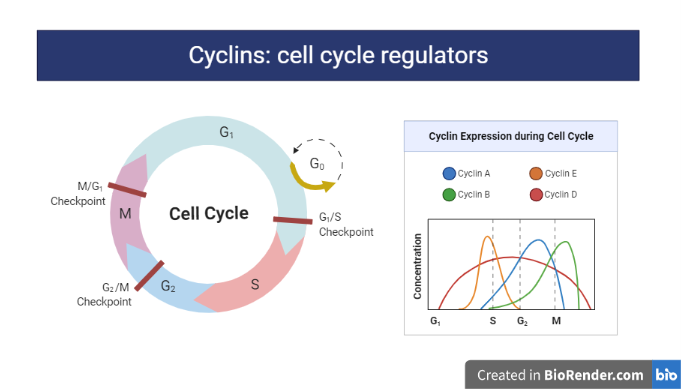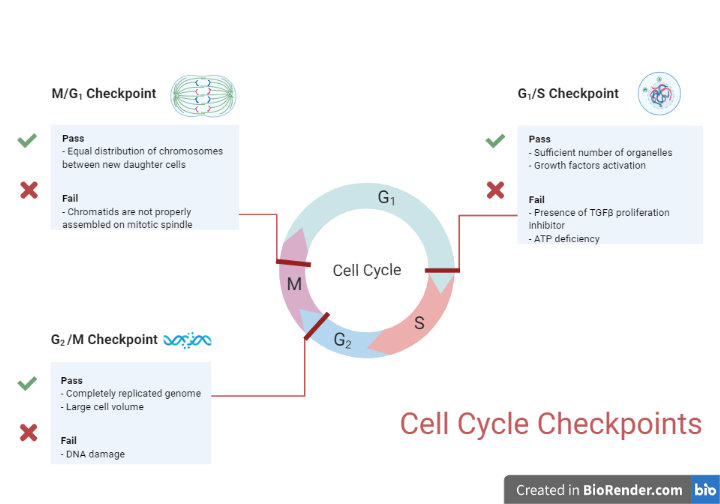Introduction:
A cell cycle is a sequence of events that occur in a cell as it divides and grows. Interphase is the stage when a cell develops, replicates its chromosomes, and prepares to divide. Thereafter, the cell exits interphase, proceeds through mitosis, and completes the division process. The offspring cells that result enter their own interphase and begin a new cell cycle.
- A cell cycle is a biological time unit that determines a cell’s life history.
- The cell cycle is a continuous process that encompasses all of the cell’s major processes, from DNA duplication to the partitioning of the cytoplasm.
- The cell cycle also includes the process of cell growth, during which the cell consumes nutrients and prepares for cell division.
- The cell cycle is divided into stages, each of which is tailored to a certain stage of the cell.
- Because of the differences in cell complexity, the overall process and phases of the cell cycle may alter between eukaryotic and prokaryotic organisms.
Major cycles:
The cell cycle is divided into three phases:
- Chromosomal cycle,
- Cytoplasmic cycle, and
- Centrosome cycle
The chromosome cycle
This cycle involves DNA synthesis that alternates with mitosis. During this cycle, the double-helical DNA of the cell replicates to form two identical daughter DNA molecules. This is followed by mitosis to separate the cell into two daughter cells.
The cytoplasmic cycle
It involves cell growth that alternates with cytokinesis. During growth, the cell accumulates nutrients and growth factors and doubles the contents of the cytoplasm. Eventually, the cytoplasm divides via cytokinesis to equally divide the cytoplasmic contents into two cells.
Centrosome cycle
The final cycle is the centrosome cycle where the centrosome is divided so that it can be inherited reliably and duplicated accordingly to form two poles of the mitotic spindle fibers.
The cell cycle is regulated by various stimulatory and inhibitory factors that decide whether the cell needs to divide or grow.
Cell Cycle Regulation:
Cyclins
Cyclins are a family of proteins that function as fundamental regulators in the cell cycle, regulating different phases of the cycle.
These proteins control the cell cycle’s distinct phases by activating cyclin-dependent kinases or other enzymes or complexes.
Cyclins are phase-specific regulators that work to keep the cycle moving in the right direction.
G1 cyclins, G1/S cyclins, S cyclins, and M cyclins are the four types of cyclins that exist in humans. Different stages are regulated by these cyclins, as the name implies.
Because of the alternating quantities of these proteins in the cell during the cell cycle, the name ‘cyclin’ was given to this class of proteins.

Fig: Cell Cycle and regulators
Mechanism
These cyclins’ concentrations are typically low, but they increase significantly if they are required during the cycle. The binding of growth factors to cell receptors, which activate cyclin gene transcription, stimulates the activity of cyclin proteins. The majority of cyclin proteins function by forming a complex with the cyclin-dependent kinases. Following that, the complex is in charge of cell cycle regulation. Some cyclin proteins, such as G1 phase cyclin D (or G1 cyclin), operate as cell cycle rate-limiting proteins. The overexpression of cyclin genes in G1 cyclins enhances the G1 transition.
Despite the fact that cyclins do not have any enzymatic activity of their own, they involve in the cell cycle via creating binding sites for other enzymes.
Cyclin-dependent kinases (CDKs)
After being activated by the binding of a cyclin molecule, cyclin-dependent kinases (CDKs) function to regulate many activities in the cell cycle.
CDKs belong to the CMGC family of enzymes, which are serine or threonine-based and distinguished by their dependence on protein subunits.
Only after the binding of a cyclin molecule and the phosphorylation of the threonine unit does the activity of these enzymes become observable.
Mechanism
- The cyclin molecules that attach to these kinases provide the enzymes extra sequences that they will need to function.
- CDKs are usually specific for distinct cyclin molecules, and the specificity of the enzyme towards its substrate is determined by the cyclin’s attachment to the CDK molecule.
- Distinct kinases regulate different phases of the cell cycle, hence the mechanism of action of these enzymes could change.
- The retinoblastoma protein is inactivated when activated CDKs are phosphorylated in the interphase (Rb).
- Multiple genes encoding proteins required for DNA synthesis are suppressed when Rb is inactivated.
- CDK inhibitors are used to regulate the cell cycle when CDKs are inhibited. The binding of other smaller proteins from the Cip/Kip family of inhibitors inhibits CDK, which controls the cell cycle.
- They act by distorting the cyclin interface and the enzyme’s ATP-binding pocket, and are likewise unique to enzymes.
- These inhibit CDK activity, resulting in a cell cycle disruption.
Cell Cycle Regulation by Checkpoints
The order, integrity, and fidelity of the major events of the cell cycle are controlled by cell cycle checkpoints. The replication and integrity of the chromosomes, as well as their proper segregation during mitosis, are all important.
Cell cycle checkpoints are milestones that ensure the normal advancement of the eukaryotic cell cycle. Each checkpoint acts as a potential cell cycle termination point, during which the cell’s conditions are examined and only when favourable conditions are fulfilled does the cell cycle advance through the various phases.

Fig: Cell Cycle checkpoints
There are many checkpoints in the cell cycle, but the three major ones are:
- the G1 checkpoint, also known as the Start or restriction checkpoint or Major Checkpoint;
- the G2/M checkpoint; and
- the metaphase-to-anaphase transition, also known as the spindle checkpoint.
The G1 Checkpoint
It is the primary point at which a cell must decide whether or not to divide. The cell becomes permanently committed to division after it reaches the G 1 checkpoint and enters S phase. That is, if no unexpected issues arise, such as DNA damage or replication errors, a cell that passes the G1 checkpoint will complete the cell cycle and give birth to two daughters.
The G2 checkpoint
The cell contains an additional checkpoint before M phase called the G2 checkpoint to ensure that cell division occurs smoothly (producing healthy daughter cells with intact, undamaged DNA).
At this point, the cell will perform the following checks:
- DNA integrity is important. Is there any DNA damage?
- Replication of DNA is a complex process. During the S phase, was the DNA completely copied?
The cell will pause at the G2 checkpoint if errors or damage are discovered, facilitating for repairs.
The cell cycle is interrupted if the checkpoint mechanisms identify DNA abnormalities, and the cell attempts to either finish DNA replication or repair the damaged DNA.
Note:
- Apoptosis, or programmed cell death, may occur if the damage is irreversible.
- This self-destruction mechanism helps to prevent cancer by ensuring that damaged DNA is not passed down to daughter cells.
The spindle checkpoints
The M checkpoint, also known as the spindle checkpoint, examines to see if all of the sister chromatids are properly linked to the spindle microtubules. The cycle will not proceed until all of the chromosomes are firmly linked to at least two spindle fibres from opposite poles of the cell, because the separation of sister chromatids during anaphase is an irreversible step. The cell will suspend mitosis if a chromosome is misplaced, giving the spindle enough time to catch the errant chromosome.
Diseases of cell cycle:
Mutations in cell cycle regulators, such as retinoblastoma protein RB1, and telomere-maintenance proteins, such as ATRX and DAXX, cause mitotic cell cycle diseases. Different types of cancer, chromosome abnormalities such as dyskeratosis congenita, which could predispose patients to cancer, and neurodegenerative diseases are among the most common of these diseases.
Key words:
- Apoptosis
- Cyclins
- Cell division
- Cancer
- Neurodegenerative diseases
References:
- Rao PN, Johnson RT. Mammalian cell fusion. IV. Regulation of chromosome formation from interphase nuclei by various chemical compounds. J Cell Physiol. 1971; 78(2):217–223. [PubMed:4333455]
- O’Connell MJ, Walworth NC, Carr AM. The G2-phase DNA-damage checkpoint. Trends Cell Biol. 2000; 10(7):296–303. [PubMed: 10856933]
- Hartwell LH, Weinert TA: Checkpoints: Controls that ensure the order of cell cycle events. Science 246(4930):629–634, 1989. [PubMed: 2683079]
- Collins, I. and Garrett, M.D., 2005. Targeting the cell division cycle in cancer: CDK and cell cycle checkpoint kinase inhibitors. Current opinion in pharmacology, 5(4), pp.366-373.
- Classon, M. and Harlow, E., 2002. The retinoblastoma tumour suppressor in development and cancer. Nature Reviews Cancer, 2(12), pp.910-917.

